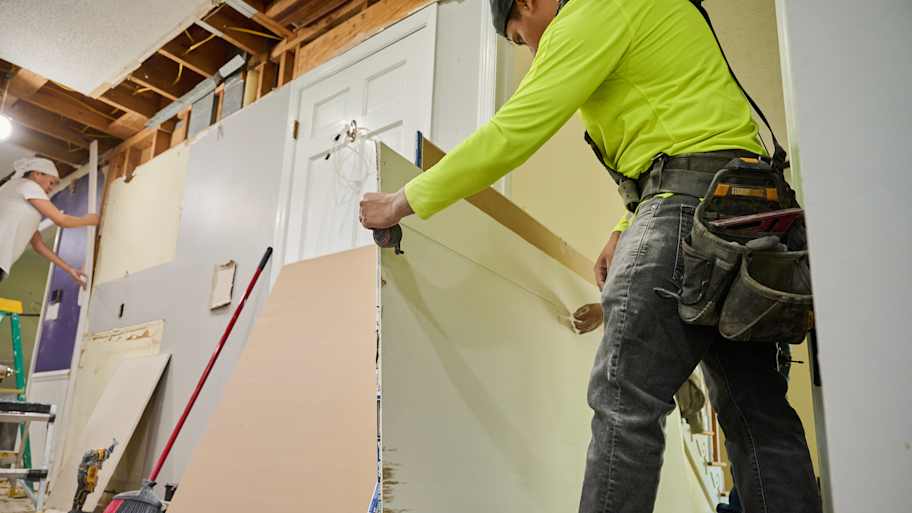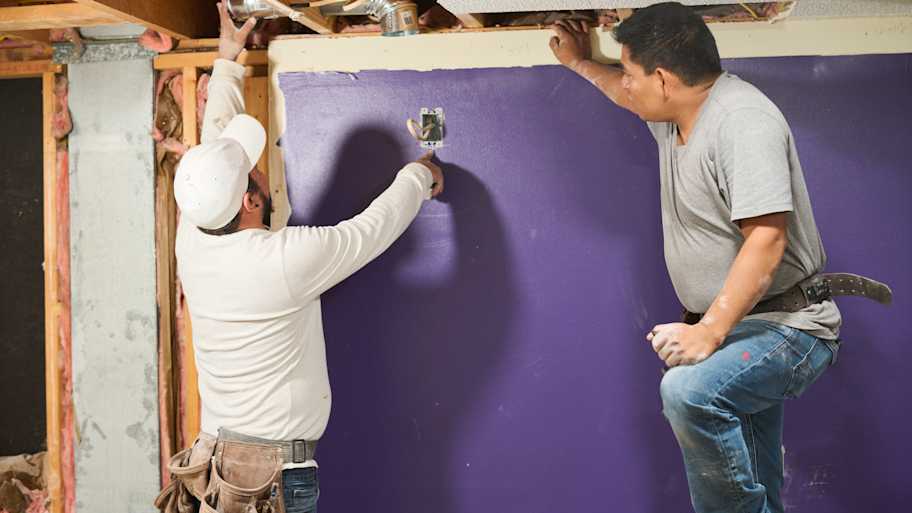Everything You Need to Know About Drywall Thickness and Size Options
Thick or thin, drywall is the go-to pick for today's interiors


Most drywall suppliers offer four thickness options to choose from.
The drywall thickness determines where and how it is used.
Drywall sheets typically measure four feet wide and are available in several lengths.
Drywall is the material of choice for constructing walls and ceilings in homes and other buildings. If you're dividing up an existing room or building from scratch, you need to know what drywall thickness and dimensions to choose. Luckily, drywall is standardized and typically comes in a few thicknesses and dimensions.
What Is Drywall?
Drywall is a material that covers the studs and boards, forming the interior walls in a home or building. Starting in the mid-1900s, drywall replaced plaster as the material of choice for new construction. You may hear some call it sheetrock, which is a brand name of drywall.
Drywall comes in panels of various thicknesses, lengths, and widths. It can also serve different functions. Some types of drywall are treated to resist moisture and limit mold growth. There are also fire-resistant and soundproofing drywall panels.
Standard Drywall Thickness Options

Drywall is available in four standard thicknesses. The drywall thickness and how much drywall you need for your project depends on where you're using it and the project goal.
The thicker a drywall panel, the heavier and sturdier it is. However, there are cases when a lightweight, more flexible drywall panel is the better pick.
| Drywall Thickness in Inches | Best For |
|---|---|
| ¼ | Walls with a slight curve or covering existing walls |
| ⅜ | Walls with a slight curve or repairing walls |
| ½ | Most interior drywall projects |
| ⅝ | Soundproofing, increasing fire resistance, or ceilings |
1/4 Inch
The thinnest and lightest option, this drywall thickness is often used on walls that have a slight curve since its thinness makes it slightly flexible. Another common use for the one-fourth inch drywall is covering existing walls, rather than tearing them down and rebuilding. You can also use it to cover a popcorn or textured ceiling, without having to replace the entire ceiling.
When it comes to lightweight versus standard drywall, these panels weigh only 38 pounds and are very thin, so they must be handled with care to avoid bending or breaking.
3/8 Inch
While not as common as other drywall thicknesses, this drywall size is often used to repair damaged areas or on curved walls.
1/2 Inch
The one-half-inch drywall is the most commonly used thickness when constructing interior walls. It works with wood or steel frames and can also be used for ceilings.
A few types of this drywall are available, including mold- and moisture-resistant. Some versions of one-half inch thick drywall are used for soundproofing, while some lightweight versions also exist for instances when weight is a concern.
5/8 Inch
The thickest option available, this drywall thickness is often the material of choice when soundproofing or when fire resistance is important. It's sometimes called fire-rated drywall.
This drywall is most often used in commercial or multi-family buildings, where noise may be a concern or where firewalls between residences are needed. While it can be used in private residences, its weight and higher cost make it an uncommon choice.
Another common use for this drywall thickness is in ceilings. Since it's sturdier than other options, it's less prone to sagging.
Standard Drywall Dimensions
Drywall comes in panel form, and those panels have standard dimensions. While it's possible to special order custom drywall sizes, if you visit your local hardware store or home center, you'll see the following sizes.
| Drywall Dimensions in Feet | Best For |
|---|---|
| 4x8 | Most drywall projects |
| 4x12 | Homes with tall ceilings or long rooms |
| 4x16 | Home with tall ceilings or long rooms |
4 Foot by 8 Foot
Drywall is almost always sold in four-foot widths, and the four-foot by eight-foot drywall panel is the most common size. This panel weighs about 50 pounds, so it’s possible that one person can carry it. However, it is often sold in stacks of two, sandwiched together, which can make it a little more difficult to transport.
Using this size of drywall gives you a lot of options, as you can hang the panels vertically or horizontally.
4 Foot by 12 Foot
Many of today’s homes have ceilings taller than eight feet—meaning you either need to use multiple drywall panels, leaving a visible seam between the two, or choose a longer drywall length. Typically, choosing the longer length is the better option, so these drywall panels are an easy-to-find option.
The longer length does mean that these panels weigh more than the four-foot by eight-foot option. They can also be tougher to carry or maneuver around corners. Plan to recruit a friend or two to help you or hire a local drywall installer to do the job.
Other Drywall Dimensions
While you are more likely to find eight- and 12-foot-long drywall panels in stock at your local hardware store, other sizes are available. For projects with tall ceilings or long rooms, you may need four-foot by 16-foot drywall panels. Drywall is also sometimes available in 10- or 14-foot lengths.
Although four feet is the most common width, your hardware store may be able to cut the drywall to a smaller size for you.
How to Choose the Right Drywall Size
For the majority of projects, 4-by-8-foot drywall sheets will be your best bet. They fit well with 16-inch on center studs and aren’t too big to maneuver. If you’re installing drywall in a room with high ceilings or a room that is especially long, you may want to go with a larger size to cut down on the number of panels you have to install and then tape and mud.





- 5 Types of Drywall and the Use Cases for Each One
- Lightweight vs. Standard Drywall: Which Is Better?
- Who Installs Drywall? Get the Right Pro for the Job
- Drywall Fire Ratings: Is It All Fire-Resistant? Here’s What to Know
- What Is Drywall Made Of?
- How to Dispose of Drywall When You’re Done With a DIY
- When Should You Hire a Pro for Drywall Repair vs. DIY?
- Should You Glue Drywall? Learn the Pros and Cons of Drywall Adhesive
- Tools for Drywall: A Complete List for DIYers
- Purple Drywall vs. Green Drywall: Pros, Cons, and Costs










